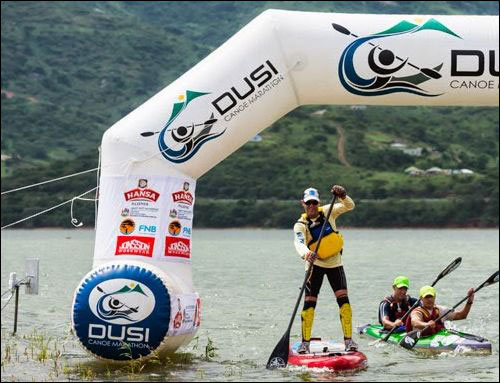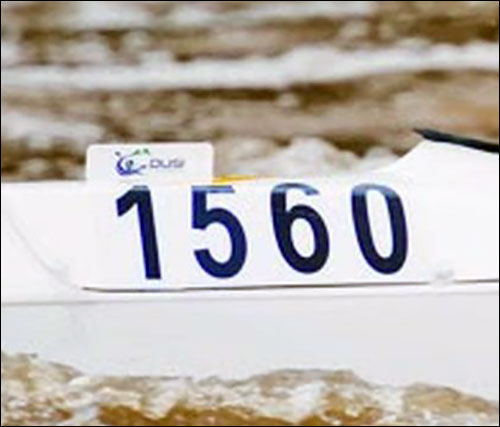The organizers of South Africa’s 120-kilometer (75-mile) Dusi Canoe Marathon were able to assess the safety and speed of racers during a rigorous race by using RFID tags affixed to their watercraft (either kayaks or stand-up paddle boards), as well as readers positioned along the course. The system not only ensured that the organizers, the Natal Canoe Club, would know when someone fell behind and might require assistance, but also provided information to each participant’s friends and family members so that they could plan to meet him or her along the course, in order to bring much-needed food and water. Finally, the solution monitored the exact time at which each racer crossed the finish line.
The system, provided for the Dusi Marathon by Finish Time Event Management, employs passive ultrahigh-frequency (UHF) RFID tags from Tadbik and readers supplied by RFID Race Timing Systems.
The Dusi Canoe Marathon, which took place on Feb. 19-21 between the cities of Pietermaritzburg and Durban in KwaZulu-Natal, is among the world’s most challenging such events. It takes three days to complete, and participants must paddle and hike the distance along the Msunduzi and Mgeni rivers, which include various sections of rapids and obstructions, as well as the presence of poisonous snakes. When the marathon was first held in 1951, the only paddler who completed the race (Ian Player, the event’s founder) reached the finish line in six days, eight hours and 15 minutes—despite his having been bitten by a night adder. Now, with lighter watercraft, paddlers are expected to finish the course in only three days, and are responsible for carrying and replenishing all of the supplies they will need along the way.
Carrying sufficient water to stay hydrated for the duration of the entire race, however, can prove difficult for a racer who must also lug a kayak or paddle board as many as 15 kilometers (9.3 miles) over mountainous terrain. In addition, with temperatures in some areas reaching 50 degrees Celsius (122 degrees Fahrenheit), running out of water prematurely can be lethal. Therefore, most participants receive water and other supplies along the route, distributed by friends. Even with the proper supplies, however, the marathon can be treacherous. Thus, says Craig Eldridge, Finish Time’s technical director, the event is not advertised on a worldwide scale, in large part because the club only wants very serious paddlers who have familiarity with the area to attempt the journey. One individual drowned during this year’s race, he says, and accidents have been fairly commonplace.
While tens of thousands of spectators arrive for the event, only approximately 1,500 participate in a total of 1,000 boats—some using doubles, others singles. The first day, they are required to complete 45 kilometers (28 miles) of the course, and a third of that distance involves portaging (carrying the kayak or board on land). Day two covers about the same distance, ending in the flat waters of the Inanda Dam. Day three is the shortest, at 35 kilometers (21.8 miles), and involves several very large sections of rapid water. If anyone fails to complete each day’s leg, he or she is disqualified from the competition.
The Natal Canoe Club, Eldridge says, does not provide any signage pointing in the direction that would keep participants on course. Instead, the racers are expected to make their own choices—which, in some cases, means leaving the river to hike along the shore, or taking a different tributary to return to the next required checkpoint. “Paddlers will be exposing themselves to risks by entering the event,” the entry form warns.
For Dusi Marathons held in previous years, the club stationed an individual on the shore at each day’s finish line, whose job it was to press a stopwatch as each participant arrived, and to manually record that kayak’s ID number on a sheet of paper, along with the racer’s finishing time. Since there is no cell phone coverage along the racecourse, participants’ supporters had to predict where to meet them along the way for water handouts. At some of the more treacherous parts of the marathon, a kayak could remain completely out of sight from everyone for several hours, so if a racer were in trouble, it would be difficult for others to realize it. The marathon posts personnel along the route to serve as lookouts, and several staff members in kayaks serve as sweepers, bringing up the rear during the race, to ensure that no one falls behind.
With RFID, Eldridge says, the club believed it could better manage participants’ safety, as well as automatically collect time-keeping information. So Finish Time began working with Tadbik to identify the best tags to use, and their best placement on the kayaks. The club wanted to keep the tag well above water to prevent any transmission interference, and found that the best location was at the front of the boat—which was also the highest point. Kayaks and paddle boards are composed of Kevlar or carbon fibers that have the ability to affect transmission, in the same way that metal would, so Tadbik built the tag to extend upright, above the surface of the kayak or paddle board, in an upside-down T. Although tags could theoretically be attached to participants’ helmets, Eldridge says—which would position them higher above the water—no helmets are worn during this event. “This is South Africa,” he points out, where athletes consider themselves too tough for such headgear.
When Eldridge approached Tadbik for an RFID tag, he told the company that he was aware of several methods of tracking canoe race times, but that he was unsatisfied with their results and reliability. Tadbik asked Eldridge about the environmental conditions to which the tags would be exposed, as well as the read range expected and the watercraft’s surface material specifications. “We tested several constructions of labels that we had in mind,” says Michal Yanuv Max, Tadbik’s sales and marketing manager, “and came up with the T-shape label to avoid the proximity of the tag to the carbon fiber materials.”
Tadbik piloted several versions of the tag internally before he was satisfied that it would provide the long read range required and survive the harsh conditions. The result is a custom-designed Tadbik tag featuring Smartrac Short Dipole tag with an Impinj Monza 5 chip that could be read from up to 14 meters (46 feet) away, using battery-powered RFID Race Timing Systems’ Ultra Readers with built-in Impinj Speedway Revolution four-port readers and MTI Wireless Edge antennas. Each reader antenna was mounted on a pole, typically planted into the riverbed, at a total of about 12 sites, generally with one reader per location (two units were used at each day’s finish line, for example, to ensure a more precise read time).
Transmitting data from the readers to the RaceTec software, provided by Australian developer Graeme Vincent and hosted on a dedicated server, provided another challenge. In this part of South Africa, cellular transmission towers are too far away to provide strong enough reception for ordinary cellular devices. Therefore, the race organizers used a 4G Wi-Fi wireless router connected to a high-gain, all-band cellular log periodic dipole array (LPDA) antenna, in order to provide an Internet connection so that each reader could transmit its data to the dedicated server. That information was then forwarded to the Dusi Race website, where spectators and the club’s management could view where each boat’s tag had last been interrogated during the marathon.
Each participant, upon checking in on the first day of the marathon, was given an RFID tag that was then affixed to his or her kayak. The ID number encoded to that tag’s memory was associated in the software with that specific participant and boat. Each time the individual passed a reader, the tag’s ID number was captured and sent to the RaceTec software, which linked the tag ID with the time and place at which the read occurred, and then forwarded that data to the Dusi website.
Spectators could visit the website to view where and when particular participants were last identified, based on the tag reads. They could then plan their meet-up with those paddlers—to provide drinks, food or other supplies—according to that information.
The data also provided a time-keeping record. The club kept its manual time-keeping system in operation alongside the RFID technology, in the event that the RFID time-keeping system (which was being used for the first time during this event) failed in any way.
However, Eldridge says, the time-keeping data was accurate and much more comprehensive than the information that could be collected manually. This, he adds, indicated how well each paddler performed throughout each day of the race, rather than just the time that he or she arrived at that day’s finish line.
The system went well, Eldridge reports. Altogether, five tags were knocked off the kayaks by tree limbs, which were then replaced with new tags at the next available stopping point.



